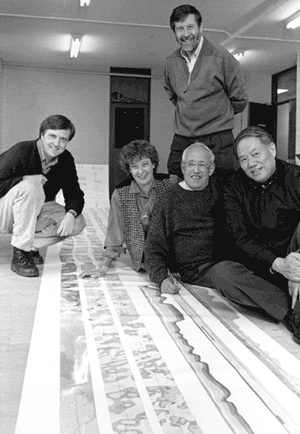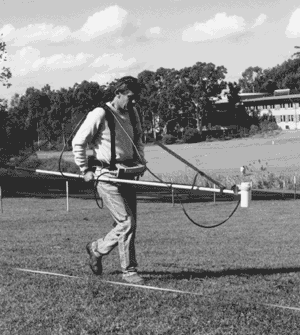Strengthening Geophysics and crossing
the geology/geophysics interface
activities 1999
Strengthening of Geophysics and integration across the boundaries of
Geology and Geophysics are major aims of GEMOC.
In 1998 these were advanced by the following:
- Following restructuring within Macquarie, Geology and Geophysics now form the Department of Earth and Planetary Sciences. This further facilitates closer linkages and interfacing in teaching, research and industry interaction.
- Laboratory facilities for in situ measurement of thermal conductivity were established at Macquarie University.
- Dr Mark Lackie, Dr Phil Schmidt and Mr David Clark continued development of the rock magnetism joint facility set up with ARC RIEFP funding (involving CSIRO and SUCOGG Universities, with Macquarie as the lead institution). A high-temperature SQUID spinning magnetometer was installed in late 1999.
- Dr Karsten Gohl continued or established research collaborations in 1999 with:
- Alfred Wegener Institute, Germany
- British Antarctic Survey
- Australian Antarctic Division
- AGSO
- North Ltd
- University of Sydney
- GEMOC had a high profile at international conferences relevant to geophysics (see Appendix 4 for titles and the GEMOC website for the full text of abstracts):
- European Geological Society XXIV General Assembly (March)
- International Symposium on Mars Exploration Programme and Sample Return Missions, ESA/CNES/NASA, Paris, France, 1-5 February 1999
- 8th Int. Symp. Antarctic Earth Sciences, Wellington, NZ (July)
- IUGG(International Union of Geodesy and Geophysics) Symposium on the Nature of the Lithosphere- Asthenosphere Boundary. (Keynote lecture and two other papers) (July)
- Equipment upgrades funded by Macquarie University have resulted in an excellent array of new instrumentation for teaching and research. 1999 acquisitions include:
- ABEM Terrameter® for resistivity and IP measurements
- 24-channel refraction cable
- GLOBE Claritas® - interactive seismic processing software
- Bartington MS2 magnetic susceptibility-temperature system
- GEMOC had continuing access to the pool of seismic detectors which form part of the ARC Seismic Consortium (headed by the University of Adelaide/Flinders University with Macquarie, Monash, Sydney, Queensland and ANU as partners and with strong support from AGSO and the Australian Geodynamics CRC).
- Collaboration in teaching and research between GEMOC and Geophysics at the University of Sydney continues,
- Dr Yvette Poudjom Djomani, GEMOC Postdoctoral Fellow, has applied her expertise in potential field geophysics (including gravity, magnetic and thermal modeling) in collaborative projects including the SPIRT project with Kennecott Canada (Slave Craton) and the extended investigation of the Siberian Platform with Western Mining and VSEGEI.
- Ongoing collaborative agreements with Chinese colleagues gave us access to extensive geophysical datasets for China and a collaborative project on gravity modeling along the southeastern section of the Global Geoscience Transect 21 (from the Philippine Sea to the Barents Sea) was initiated with the Geological Survey of China and the Institute for Gravity, Xi'an (in collaboration with Professor Yuan Xuecheng, Professor Wang Ping and Mr Yuan Binqiang).
- The collaborative project with Western Mining Corporation on gravity modeling across the Siberian Platform was extended to the west in 1999 to include the region around the Noril'sk nickel deposit. This project is also in collaboration with Dr Y. Ericheck of VSEGEI (St Petersburg) who are providing some geophysical datasets.
- GEMOC is participating in the Geophysical Transect across the northern boundary of the Yangtse Craton, funded by the China NSF and organised by the Chinese Academy of Exploration. GEMOC's role includes interpretation of the gravity data on a collaborative basis and integration of petrological and geochemical data with all the available geophysics on the Transect.
- Professor Paul Morgan was one of nine scientific investigators for the New Millennium Program Deep Space 2 Microprobe Project Science Team chosen by NASA to guide the science on this mission. Paul was part of a team that designed the small probe that was to penetrate the Martian surface to detect the presence of any water. Unfortunately no signals were returned from the mission. Paul spent the "target day" at the Powerhouse Museum Theatre as the main guest speaker about the mission.
- Major advances were made in understanding the interpretation of geophysical signatures of some types of large-scale lithosphere domains (eg Publications, 132, 137, 139, 144, 154).

One of GEMOC's major geophysical projects is the interpretation of
lithospheric structure along the Global
Geoscience Transect 21 from the Philippine Sea to the Barents Sea.
David Clark (CSIRO), Sue O'Reilly, Bill Griffin, Lev Natapov and Yuan Xuecheng
(Chinese Geological Survey) discuss the 12 metre-long section.
new research projects
- Investigation of the nature of the lithosphere beneath the Rio Grande Rift. Professor Paul Morgan initiated this GEMOC project in collaboration with Professor R. Keller from the University of Texas and Professor N. Christensen from the University of Wisconsin (Madison). Collection of mantle and lower crustal xenoliths from Kilbourne Hole and Potrillo Maar provided samples for geochemical and thermal conductivity analysis. Funding for a seismic profile is being sought.
- Modeling of the effective elastic thickness of selected regions in Siberia, Australia, China and specific other regions globally (relevant to exploration targeting) and integration with thermal and magnetic signatures and datasets.
- Determination of a Carboniferous paleomagnetic pole for the Newcastle Range Volcanics in North Queensland. (see Research Highlights) This is a postgraduate project by Kari Anderson who was awarded a Macquarie University international postgraduate scholarship from 1999.
- Petrophysical study of the upper mantle and lower crustal xenoliths from the Kerguelen Archipelago and integration of acoustic velocity results with seismic profiles. This project is in collaboration with Dr Ian Jackson, ANU. (see Research Highlights)
- Thermal studies of the Australian lithosphere including: silica heat flow studies, modeling heat flow and paleo-heat flow with experimentally determined parameters for thermal conductivity (at different T and P) and heat production of realistic geological lithospheric sections. (A relevant PhD project continued in 1999 (Mark Pirlo))
- Modeling of density of different types and compositions of lithospheric mantle to assess mechanisms of mantle overturn and thinning in regions of different age, thermal structure and tectonic environment (see Appendix 4 abstract for Keynote address at IUGG, 1999)
- Identifying the origin and composition of the oceanic Agulhas Plateau, SW Indian Ocean. This includes further testing of hypotheses of continental fragments, an anomalous upper mantle density and its origin, and a revised plate-tectonic reconstruction of the region. (In collaboration with the Alfred Wegener Institute Antarctic Survey cruise.)
- Investigation of the paleomagnetism and rock magnetism of rocks from the Lachlan Fold Belt continued.
new teaching activities at Macquarie
- The named degree, Bachelor of Geophysics, continued after its inception in 1998 to increase the visibility of Geophysics
- The Bachelor of Technology in Exploration Geoscience has a Geophysics strand initiated in 1999, streamed from the second year level (see flow sheet on Appendix 6)
- Use of an extensive pool of GPS units for undergraduate (and postgraduate) fieldwork continued. Subscription to time signal allows real time differential applications with mapping resolution of 10-15 metres. Use of GIS-based mapping program with portable computers starts at the first-year field camp to provide industry-standard training.
- Upgrade of differential GPS units to allow cm resolution required for detached gravity surveys
- Extended implementation of new seismic, gravity and resistivity for student field projects in exploration, groundwater, environmental and engineering geophysics.
- A SUCOGG Honours course addressing seismic and radar data-processing was offered in cooperation with the University of Sydney in 1999.
- Honours research programs integrating Geology and Geophysics components were completed in 1999 (Jason Berton, Tara Deen).
- Involvement of excellent senior students in teaching activities such as seismic fieldwork

Geophysics training at Macquarie

 GEMOC ARC National Key Centre
GEMOC ARC National Key Centre